Problem solving can be seen as one of the challenges or our daily life. Some of the dilemmas we are confronted with require careful thinking and planning. Solving them can turn out to be a big task and it seems like a structured, well-defined path to take isn’t always available for achieving a satisfactory result.
The purpose of this article is to demonstrate that any kind of problem, of major or minor difficulty, irrespective of its nature, can be resolved in a creative, structured way.
The instrument I will use in order to exemplify this claim is a scientific method called MCAA.
The MCAA method
The MCAA (multi-criteria advanced analysis) method can be used with exceptional results in many situations:
-
different types of rankings
-
weighing of several alternatives (variants, subjects) and if necessary, selecting the best
-
establish an order of value for several variants (alternatives), in light of some criteria
-
compare one or more variants of own choice with existing variants of a product, object, etc
Consequently, the method can be applied in any domain where creative problem solving is required. As an example, it can be determined who is the best cyclist or actor, of all times, or what person to hire in a position, or which variant of a design best satisfies us from a cost point of view, and so on.
It is necessary to mention that this method tends to produce results with a high degree of objectivity.
MCAA is based on a mathematical model that I chose not to expose here. Instead, the presentation will be centered on a software program that hides the complexity and the mathematical nature of MCAA and provides a good high-level overview in order to give not-so-mathematically-inclined people a chance to follow.
While very general and complex, this wikipedia article gives an overview of the mathematics behind various decision-making methodologies.
I had the chance to study decision-making (and MCAA implicitly) with the occasion of my university studies, and I developed the software I will present later in this article while working for my graduation project.
The MCAA method consists of several steps:
Step 1 - Establish criteria
A criterion is a clear and well defined point of view of the specialist (domain expert, analyst), or of any interested person by which he (alone or in teams) delimits, defines certain properties, attributes, features of the analyzed object.
The most important criteria (which can be many of course - therefore the analysis is called ‘multi-criteria’) must be found so that the result will be meaningful and unambiguous.
It is recommended that finding and choosing the criteria should be done in one or two brainstorming sessions, followed by a morphological analysis (If there is interest, I will describe in future articles the morphological analysis technique, together with some examples).
Step 2 - Determine the ordering of the criteria
-
the ordering of the criteria is established by comparing every 2 between them
-
when judging the relative position of two criteria there can exist only 3 situations: a criterion is more important than another, a criterion is as important as another and a criterion is less important than another
These two factors are some of the strongest reasons that demonstrate the highly objective nature of the MCAA method.
Determining the order of the criteria will have as result a weight coefficient for every one of them
Step 3 - Identify variants
By variants we understand subjects, products, objects, realistic solutions that meet the same end uses or purpose.
Step 4 - Grade every variant
A grade should be an integer (maximum 10). It is also called ‘importance grade’ or ‘contribution of a variant to a criterion’.
Each variant is examined in light of each criterion (and graded) until all options are exhausted.
Software
In order to have a complete image about MCAA mechanics, I will introduce a piece of software designed specifically for introducing the method to the world.
Please note that this program has been written around the year of 2008 and, at that time, software usability principles were largely unknown to me. With that being said, I still believe it is worthy enough to be presented here.
The quality of this software does dot reflect my current skills as a software craftsman.
Tutorial
What follows is a demonstration of MCAA using the program as a reference guide.
It is recommended that you follow this tutorial with the program open. If you find yourself confused then you can always scroll to the description of each step in order to understand what is expected of you.
Imagine that a company desires to hire someone for a position, and ‘Tim’, ‘John’ and ‘Jane’ are three candidates that are to be ranked with respect to their overall suitability for the job.
Step 1 - Establish criteria
The first thing needed is to identify the criteria that are of utmost importance in the current situation. The fictional company’s hiring team came up with the following:
- Education - has at least a BA
- Experience - has worked at least 3 years
- References - recommended by one of the team members
- Social skills - communicates clearly, displays leadership traits
- Enthusiasm - has read our blog, knows our business model
- Salary - budget for this position: max 40.000$/year
Type (or copy/paste) them in the text area, in the ‘Write your criteria’ zone, as exemplified in the following image:
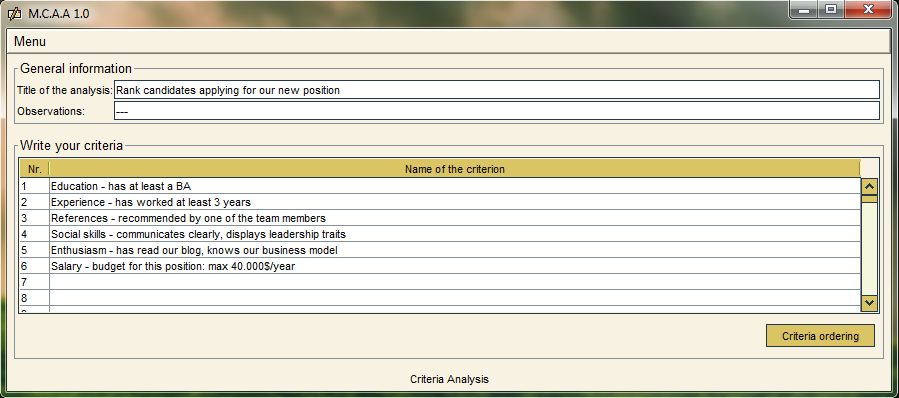
When you are done, press the ‘Criteria ordering’ button.
Step 2 - Determine the ordering of the criteria
At this step, the program offers you the opportunity to compare each criterion with the others.
Move the sliding selector using the arrows < > and make your choice using
the buttons on the right side of the panel.
As an example, for the first option, you should read: “The selected criterion (Education) is [more important/as important/less important] than the selected criterion (Experience).
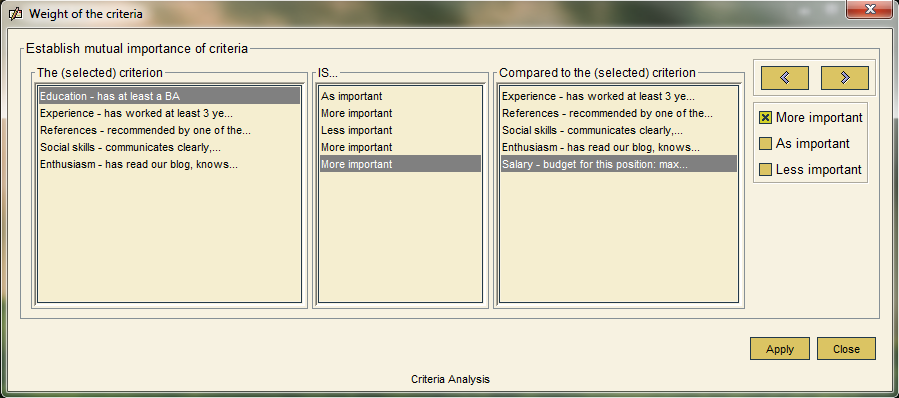
After all comparisons are done, press the ‘Apply’ button, and you will see the result in a graphical format, based on the decisions you made.
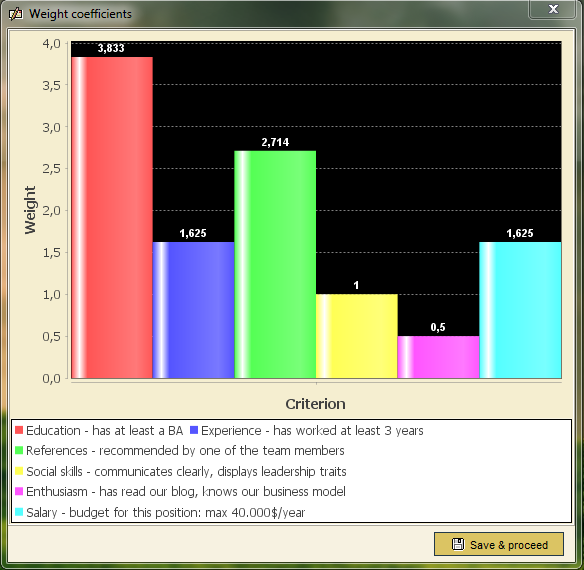
At this stage, had you been mathematically and calculus oriented, you would have had to work through the calculations. Luckily, the program hides them completely from you.
Press the ‘Save and proceed button’, you will be forwarded to the next step.
A side result of this action is the fact that the analysis is written on a file located in the same directory from where you launched the program (see the end of the article for an example).
As you’ve probably gotten used to, a window pops up. The description on the window is self-explanatory, but note that by choosing ‘Criteria’ you can add (even remove) new criteria or modify the choices you previously made. Just try it out.
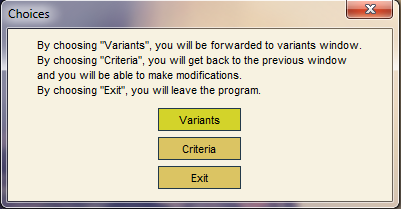
Step 3 - Identify variants
Just write or copy/paste your variants and the press ‘Grade variants’.
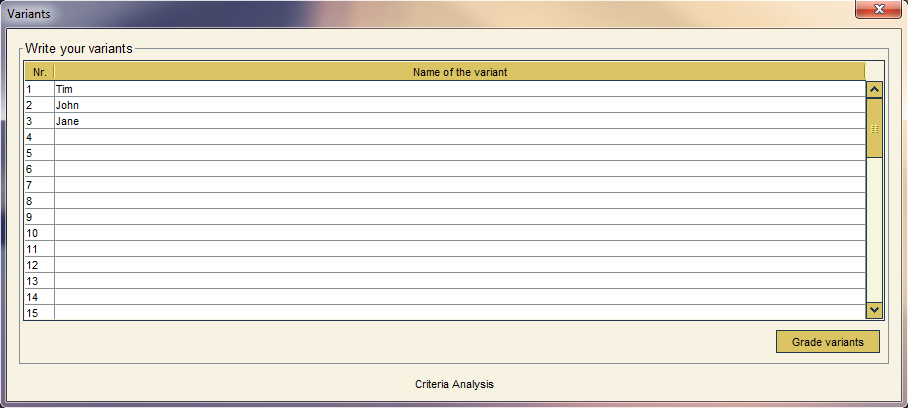
Step 4 - Grade every variant
The way you should interpret this: “In light of the selected criterion (Education) the selected variant (Tim) is worth [1/2/…/10] points”
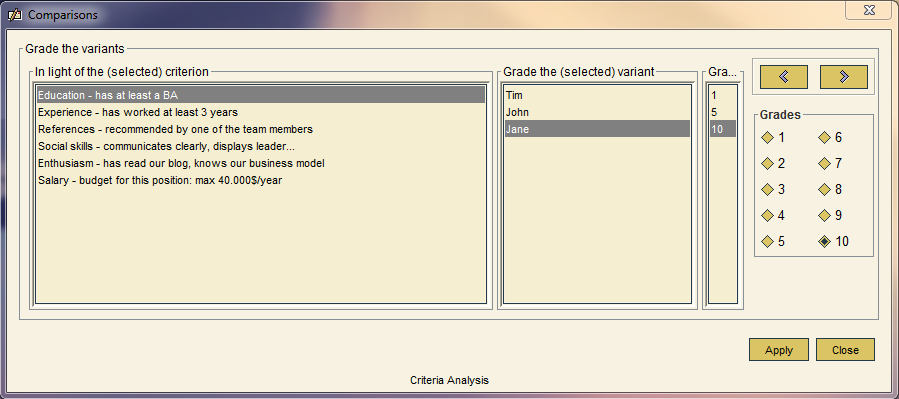
After you finish all the grading, you will be presented the interpreted results of your analysis, in a graphical format.

Next, decide if you want to add/remove another variant, or re-do the grading. The program allows that, just try it out.
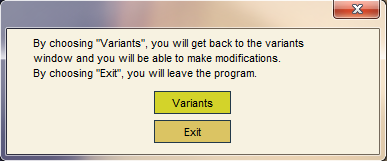
As said earlier, the program produces a file called “M.C.A.A-1.0.data”. This is a fragment of that file.
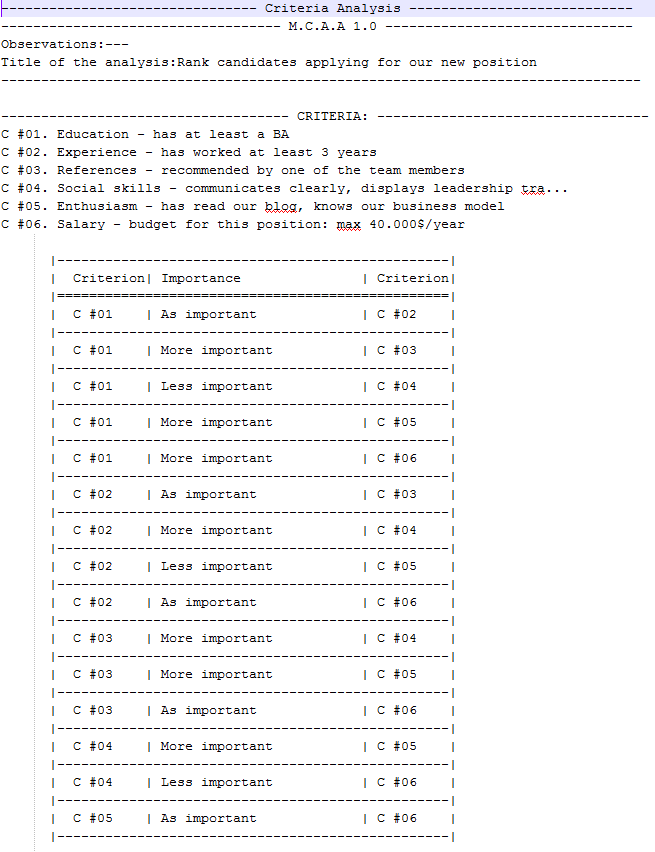
Downloads
In order to run this program, you need java installed.
####For Windows users
You can get the program from this link
####For Mac and Linux users
You can get the program from this link
The download is a java archive, run it by double-clicking it or in a terminal:
java -jar mcaa-1.0-all.jar
